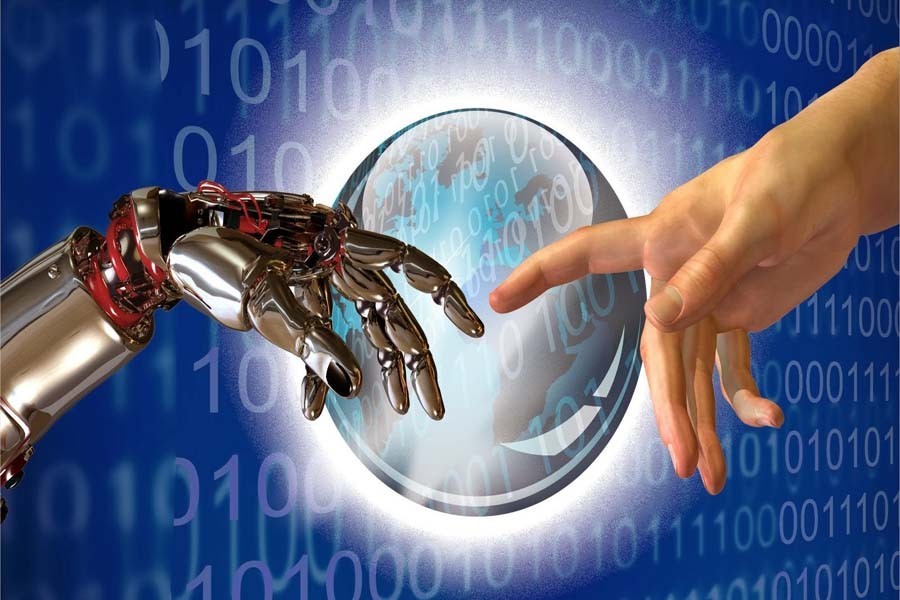One big issue that is being talked about in business, the academia and every forum concerned about human problems nowadays is the Fourth Industrial Revolution. The subject matter of all such discussions is how it is going to impact us and how to prepare ourselves to welcome it once it crashes onto our shores.
The phrase 'Fourth Industrial Revolution' was first coined by the German economist Klaus Schwab, author of the book, 'The Fourth Industrial Revolution' and Founder and Executive Chairman of the World Economic Forum (WEF).
In fact, we are already in the midst of the Fourth Industrial Revolution, or in short, 4 I. It is marked by the connected world that has been made possible by the earlier digital information technology-driven transformative changes taking place all around us. It is profoundly affecting our lives by connecting everything with everything that humans do in an unprecedented way.
From that point of view, professor Klaus Schwab's labelling such transformations as the Fourth Industrial Revolution or 4 I, has only made us all aware of it. And the new awareness has opened the floodgate of the discourse on 4 I.
Earlier, technological revolutions were about how machines made our physical work easier and faster with the invention of the steam engine in the second half of the 18th century. It marked the end of the agrarian feudal past and ushered humanity in to the urbanised industrial society based on mechanical production. In the third quarter of the 19th century, electricity brought with it the second industrial revolution. It enabled mass production with the introduction of assembly line. The industrial economy started by steam power in the eighteenth century now gathered unprecedented pace. Then in the second half of the 20th century, semi-conductor-driven electronics took mechanical computing on a hyper drive. It started the era of machine programming and automation. The third industrial revolution moved industry into the automation age.
The second decade of the 21st saw another transformative change taking place before eyes of those who in their youth were awed by the wonders of computer and the automation it made possible. Now began the fourth industrial revolution with the computerised archives of data and information lying in faraway locations across the world through the global online network, the internet. Industries have become smart and they are now managed online. To all appearances, it looks just like the extension of the third industrial revolution that took shape in the 1950s and 1960s.The point of departures of the third and the fourth industrial revolutions from the earlier two is that the time span between the last two is far shorter and mostly overlapping. In fact, no new technological shift marks and separates the third and the fourth industrial revolutions. The fourth industrial revolution, or 4 I, is basically a merger of the different scientific disciplines and the technologies they promote. For example, digital technology and bioengineering, both products of the third industrial phase, are working from the same platform reinforcing each other's potential and promising unforeseen spin-offs out of the mergers. So, the fourth industrial revolution is essentially about interface as well as merger of the already existing sciences, technologies and production processes. Looked at from the perspective of technology there are also some distinctive developments that may be listed as the features of the 4 I.
Take the case of the artificial intelligence. It is going to be one of the key drivers of the 4 I as it would with its power of discerning patterns in data, of analysis and reaching conclusions will be able to make possible ever newer mergers and interfaces between diverse fields of human interest. Economy and society will undergo new transformations as a result.
Another feature of the 4 I is the internet of things (IoT) where the physical and the digital worlds merge. Systems are getting smarter as devices are getting digitally interconnected.
Evolving robotics making robots work in collaboration with humans are so-called cobots. They promise to make production environments less monotonous and risk-free.
The meeting of the real world and the digital creates new experience for humans, an enriched immersive experience. The upshots are virtual and augmented realities made possible by computers.
Big data are another feature of 4 I. Enormous amount of data could be crunched, mined with help from artificial intelligence (AI) creating information for use of business, advancement of scientific research.
3D printing is around for some three decades and undergoing major improvements. It creates three dimensional copies of things, prototypes, by putting layer upon layer of two-dimensional components of objects. It promises revolutionising manufacture yet another step further. But 4D takes advantage of material science and properties of new kind of plastics and biomaterials that have the ability to unfold/ evolve into different shapes over time. The full potential of 4D is yet to emerge.
But the 4 I is not just about technologies.
In the words of the Klaus Schwab himself: "It is characterisation of fusion of technologies that is blurring the lines between the physical, digital, and biological spheres".
There are hopes, dreams, and fantasies, no end of them, surrounding 4 I. And also fears. Many celebrated scientists including Stephen Hawking warned humanity against the dangers of one key feature of 4 I, the Artificial Intelligence. Such doomsday pictures of the future were portrayed by many no-nonsense thinkers at the dawn of every major shift in technological progress in human history. There were serious writings, films and science fictions that imagined a world controlled by robots and people are at their mercy. Similar fears abound surrounding the advancement in biotechnology. But such warnings notwithstanding, the march of science and technology has never stopped and will not stop. But the fears are also not unfounded. The dangers of the internet, more particularly, of the social media are for all to see.
As such, humanity needs to strike a balance between the opportunities that the 4 I is opening up and the potential risks it holds.


